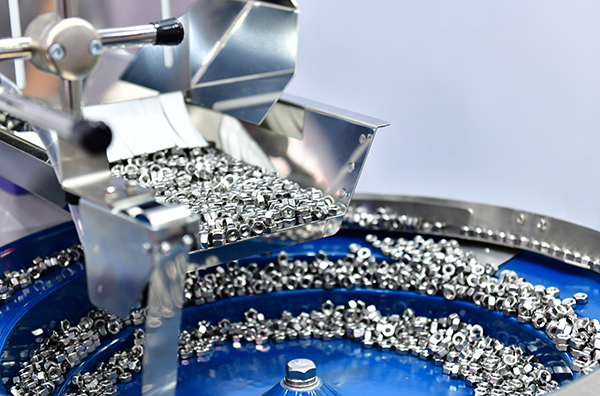How Light Manufacturers Can Successfully Reduce Waste
Partnering with the right waste solutions provider to recycle, repurpose or reuse will help to reach sustainability goals.

Bolts and nuts are manufactured. Waste minimization is a key pillar in many light manufacturers’ corporate sustainability plans. (Credit: Clean Earth)
Light manufacturers that are willing to invest in long-term partnerships and expand past historical norms in business practice may uncover new ways to fast track their sustainability results, with minimal or no changes to front-end production models. Organizations that are working with partners to implement sustainability initiatives today have a competitive edge, as consumers are looking for a strong sense of corporate responsibility and a solid environmental track record.
Thinking sustainably
Waste minimization and carbon offsets are key pillars in any corporate sustainability plan. Light manufacturers and distributors are no different in this regard. One of the key challenges for light manufacturing waste elimination is that there is such a large variety of byproducts, given the various designs of the product itself and the packaging around it. Additionally, the type of materials produced varies, based on the different kinds of manufacturing. A byproduct’s flow through manufacturing facilities and its distribution channels provides additional challenges.
Though most light manufacturers hold some sustainability goals, many of these organizations are still focused on traditional disposal methods, such as landfilling instead of placing an emphasis on reuse and recycling. Manufacturers are, of course, remaining in compliance with federal and local regulations by using traditional models, but may not be achieving or advancing their corporate sustainability goals.
Another challenge is that leaders in the light manufacturing facilities and distribution facilities often wear many hats. Due to time constraints, professionals in the all-encompassing Environmental, Health and Safety (EHS) role are often required to focus on the health and safety of their employees and compliance of their facilities before focusing on the environment.
Most companies are exploring opportunities to improve the composition of their byproducts to reduce or eliminate the dependence on fossil fuels and plastics. As mentioned above, consumers are increasingly focused on the sustainable practices of a brand; this makes waste disposal and waste minimization essential components of a successful customer retention strategy. One way to alleviate some of this pressure is to employ a third-party sustainability partner.
Choosing a partner
Achieving zero waste is a journey – it is not a one and done deal. Finding a sustainability partner who can solve the very difficult challenge of properly managing difficult-to-treat wastes is a critical step.
Key areas to look for when vetting this third party include:
A history of solutioning success in similar sized companies with similar goals.
Interest and commitment in the company’s specific needs and goals.
A robust network of recycling and reuse outlets or strong vendor partnerships, to offer a variety of waste alternatives.
A committed timeline and method to track outcomes clearly and consistently.
A history of valid permitting and compliance reporting by all parties involved in program management.
Some light manufacturers might find that they do not generate wastes in large enough volume to support standalone alternative solutions, like a larger company does, to achieve risk avoidance and sustainability goals. Utilizing a partner can ensure that even smaller quantities of waste can be combined and consolidated with others and recycled/disposed of in a sustainable manner. The partner can also look beyond just the waste streams coming out of a facility – and focus on process flows and upstream impacts to name a few.
It’s also important to partner with the experts that focus on sustainability and build sustainable programs day in and day out. These experts will ask the tough questions and get to know site and company goals, while remaining realistic about the challenges a light manufacturer has had in the past and today. Being compliant based on the information at hand is important, but as regulations continue to change and become more stringent, compliance may look different. Partnering with a third party can help the manufacturer prepare and look forward to these changes so they are not caught by surprise.
Closing thoughts
The increasing levels of engagement in sustainability are powering the “market of the future” and accelerating progress for the environment. Whether a light manufacturer is just beginning its sustainability journey or is looking to move towards zero waste, the most important part is to identify a trusted sustainability partner who has the ability to help the organization meet those goals.
Recycling and reduction doesn’t happen overnight, so the strategy should be to build a relationship that can look at all the pieces that play into waste generation over time. The right partner will drive sustainability by uncovering long-term solutions, ultimately helping the manufacturer become a more sustainable company.
About the author
Holly Gamage is the Senior Director of Clean Earth’s Fullcircle™ business, an Advanced Waste Lifecycle Program. This program strategically analyzes waste and all related byproducts at each source of generation, including upstream, then builds and offers solutions for recycling and beneficial reuse alternatives for the material. Holly is responsible for the overall operations, client services, innovation, continuous improvement, development and implementation of Fullcircle™. Her leadership has led to teams providing creative innovative solutions for recycling, minimizing waste and building sustainable client partnerships and superior customer-centric programs exceeding client KPIs.








